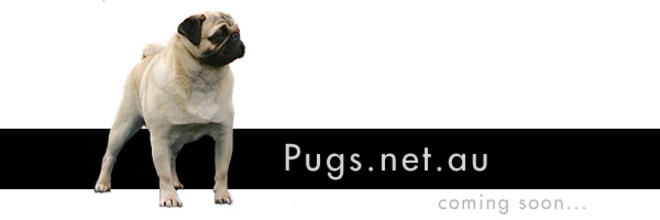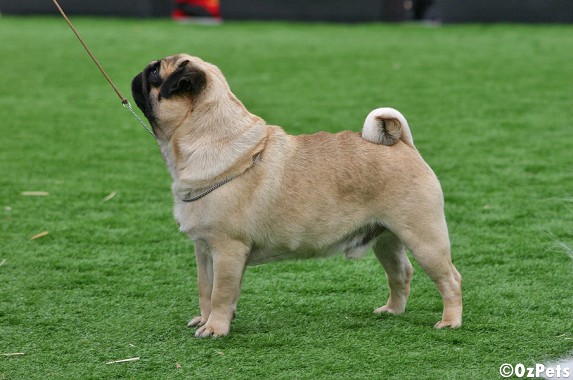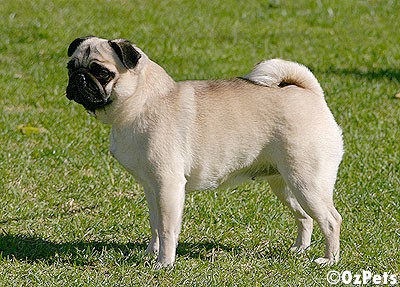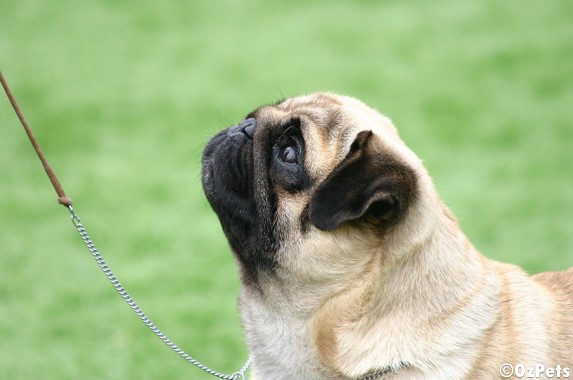
THE PUG The Pug, believed to be one of the oldest dog breeds, originated in China. They were favoured by the Chinese nobles and made their way to Europe in the late 1500s when China began trading with the western world. Pugs became popular amongst the royal households of Europe and notable owners were Queen Victoria and Marie Antoinette. The Pug has been known by a number of names across Europe including Carlin in France, Mops in Germany, Caganlino in Italy, Mopshond in Holland and Dogullo in Spain. Some believe the origin of the word Pug comes from the Latin Pugnus, meaning a balled up fist as the wrinkles in a Pugs head might look like a fist. An alternative theory is that the Pug resembled the popular, at the time, "Pug" monkey. While Pugs were known as the Dutch Mastiff as they share some similar characteristics they are not members of the Mastiff family.
The Pug, believed to be one of the oldest dog breeds, originated in China. They were favoured by the Chinese nobles and made their way to Europe in the late 1500s when China began trading with the western world. Pugs became popular amongst the royal households of Europe and notable owners were Queen Victoria and Marie Antoinette. The Pug has been known by a number of names across Europe including Carlin in France, Mops in Germany, Caganlino in Italy, Mopshond in Holland and Dogullo in Spain. Some believe the origin of the word Pug comes from the Latin Pugnus, meaning a balled up fist as the wrinkles in a Pugs head might look like a fist. An alternative theory is that the Pug resembled the popular, at the time, "Pug" monkey. While Pugs were known as the Dutch Mastiff as they share some similar characteristics they are not members of the Mastiff family.
The Pug, a member of the Toy Group of dogs, is a small, square, compact dog with well-developed muscles that generally weigh no more than 8kg. Their heads are broad and round, with large circular eyes. They have a short, flat, black muzzle with deep wrinkles and their bottom teeth typically protrude somewhat further than the top, giving them a slight underbite. The tail is tightly curled and arched over the back with a double curl highly desirable. Pugs have a short, double coat, that is either black or fawn in colour with a few tonal variants. The fawn or tan coat colour can range from a warm apricot to a cool and rarely seen silver. Pugs shed their coats heavily especially during warmer months and require regular brushing to remove dead hair. They should be bathed at least once a month to keep their coat and skin healthy.
Pugs have a short, double coat, that is either black or fawn in colour with a few tonal variants. The fawn or tan coat colour can range from a warm apricot to a cool and rarely seen silver. Pugs shed their coats heavily especially during warmer months and require regular brushing to remove dead hair. They should be bathed at least once a month to keep their coat and skin healthy.
Facial wrinkles are a problem area for the pug. If left damp or unclean, these folds become breeding grounds for infection so should be wiped clean often. After bathing, the wrinkle folds must be dried properly. Pugs eyes, being so prominent, are susceptible to injury and irritation and should be protected from soaps and chemicals when bathing; ears should be examined and cleaned when required, and nails should be trimmed regularly.
Pugs are joyful, loving, loyal, charming, playful, and mischievous and love to be the center of attention. They are bred to be a companion dog, and are at their happiest in the vicinity of their owner or other family members. Small in size they make the ideal lap dog and prefer to be indoors so are well suited to city living. Pugs enjoy the company of children and get along well with other dogs, cats and pets. They rarely bark but can snore loudly because of their flat nose. Pugs are highly intelligent and generally eager to please but they can be stubborn and headstrong at times which can make training challenging. They need daily exercise in the form of a short walk or active play but care must be taken on warmer days as they are susceptible to the heat and humidity.
Pugs are highly intelligent and generally eager to please but they can be stubborn and headstrong at times which can make training challenging. They need daily exercise in the form of a short walk or active play but care must be taken on warmer days as they are susceptible to the heat and humidity.
While the Pug is a low-maintenance breed, they may face several health problems owing to their Brachycephalic nature, which refers to any dog with a flattened or squashed-in muzzle. Pugs can have difficulty breathing when they are stressed or in hot weather so should not spend too much time outside and monitored for overheating. Pugs are also susceptible to obesity as a result of their sedentary lifestyle and love of food, therefore nutritious diet should be maintained and snacks and goodies should be avoided. Regular grooming will also prevent issues with their skin and eyes.
Overall, the Pug is an excellent companion for people who want to keep their lives quiet and are well suited to older individuals. They may be amusing and entertaining, but they're also eager to relax and unwind and are totally devoted to their owners.
Pugs have a lifespan of around 12 to 15 years.
Height: Female: 25-30 cm, Male: 30-36 cm
Weight: Female: 6-8 kg, Male: 6-9 kg